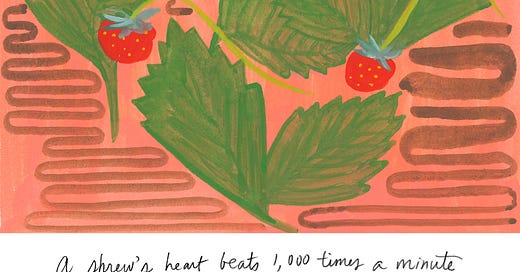Hi, friends — this is issue #17 of my newsletter about animal encounters. Sometimes I draw a thing and say “huh,” which is where I’m at this week, still seasonally aspirational and now thinking about strawberries. Also thinking about how the earth is full of short-tailed shrews (Blarina brevicauda). Let me know if you’ve seen them, I’d love to hear. — AJP
I’ve seen these small creatures on occasion, rarely, most recently belly-up on a cold morning (winter is hard). I’ve also seen the zipline-trail they leave on fresh snow, like a signature, “I was here.” Short-tailed shrews are tiny, maybe five inches at most, though certainly not the smallest of shrews. If you can imagine their perfect, peanut-sized paws and pinprick eyes under silver fur, you might imagine the strange world in which they live.
Short-tailed shrews do not hibernate. In winter, they leave their warm fur-lined nests (under logs, in the earth) to forage, tunneling where earth and snow meet. I’ve often wondered about this pocket of air in-between, under the snowlight. What beauty and drama must exist in this temporary layer, between seen and unseen?
Shrews live most of their lives underground and along the leaf-litter horizon, tunneling at pace, without need of strong eyes (hence the pinpricks). They use their sensitive whiskers and sense of touch (and possibly echolocation) to find their way. Shrews must consume enormous quantities to maintain their body heat and weight and are voracious eaters of seemingly everything: seeds and insects, especially snails and earthworms, but also other small mammals like mice and voles, and even other shrews.
Their secret ace is the venomous poison they wield. Short-tailed shrews can take out larger prey with their neurotoxic saliva (don’t worry, it’s not enough to hurt you or your pets). They are the only venomous mammals in North America and can hoard live prey (creepy and disturbing but effective for the shrew). Even so, life is fast and hard at small scale, and shrews are snack-sized bites for owls, snakes, and even some fish, if circumstances allow (most mammals don’t like the smell of them).
Mating season for short-tailed shrews begins now, in March, and you can imagine a din of ultrasonic vocalizations happening under your feet as males court females. Litters are usually six to eight teeny babies, which the mother cares for and nurses for a few weeks before they make their way into the world.
Short-tailed shrews are one of the most common animals within their range, covering a large swath of North America. But I would be surprised if many people have seen them. When I’m at my most contemplative (usually washing dishes, looking out the window), I wonder about the barely intersecting worlds in which we exist, one atop the other. The snow is stubborn and still thick in the shadows but soon a whole new world will emerge, extending in all directions from this layer, between seen and unseen, where the short-tailed shrew reigns.
Northern short-tailed shrew links—
This 3-min. video of a short-tailed shrew attacking a snake, plus another shrew fight, is completely berserk. [National Geographic]
All species of shrews are wonderfully strange; just look at this video of a conga line of a mother and her babies (it’s really crazy). [Imgur]
Speaking of kitchen-window contemplations—
Biologist Jakob Johann von Uexküll created the idea of the Umwelt or “self-world,” as if we animals, with all our different perceptive capabilities, occupy slices alongside each other. I don’t know enough about it, but I find it fascinating. The Wikipedia entry includes Uexküll’s description of ticks, which made me sympathize with them in a way I thought impossible. [Wikipedia]
“Observing nature in your backyard is not dull but radically significant” this article by Yadvinder Malhi, professor of ecosystem science at Oxford, brought a lot of things home for me, at Psyche. Thanks again to Sophie Yeo’s brilliant newsletter Inkcap for the link.
Animal encounters in recent comments—
Seeing gray squirrels through new eyes, with thanks to Louise. And my sis saw a nice plump one trying to get back into its tree (does it make it? find out here!).
Also—
Next week: a Spring Equinox surprise! (Always happy to take suggestions; please let me know if you have one.)
If anyone needs a drawing of a small, cute venomous berserker in a strawberry patch, please let me know; short-tailed shrew is for sale.
The word “snowlight” comes from Tove Jansson’s The True Deceiver. I think about it every winter and have used it before, in these quick drawings from 2010 (what is time?).
This newsletter is a small weekly adventure about the life around us; thanks for reading and sharing with friends and family. Have a great weekend and see you next Friday.





Thank you for this! The snow JUST thawed where I am in VT and I have noticed the remains of their little shrew paths and now I know!
You just be sent me down a rabbit hole, er, shrew tunnel! I hadn’t thought much about shrews. My mum in law had a cat that delighted in depositing them on the porch. He would drool profusely after “playing” with one, a by product of the toxin.
Oregon is home to ten kinds of shrews. Two interesting variants: Preble’s Shrew, which live in our high desert sage lands, and the Pacific Water Shrew—a shrew that swims!
Thanks for the conga line of mom and babies. I’ll be watching it on repeat all day while I procrastinate about grading papers.